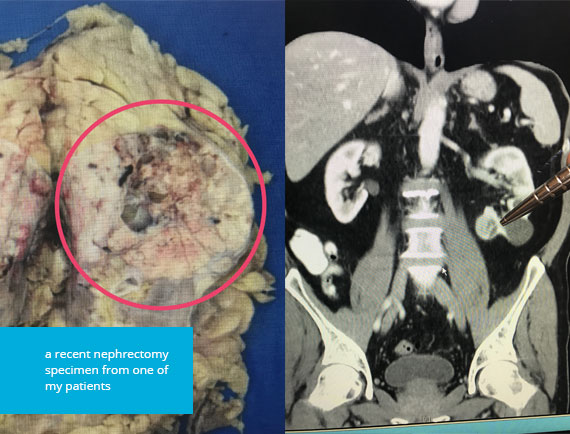What are the kidneys?
Most people have two kidneys. They sit at the back of the body, one on each side, just underneath the ribcage. The kidneys filter the blood and remove waste products, which they convert into urine.
Kidney cancer
Kidney cancer is the 9th most common cancer in Australia effecting around 3,000 people each year. It is more common in people over 60. Usually only one kidney is affected. There are different types of kidney cancer but about 90% are renal cell cancers (RCC). Other types of cancer include papillary, chromophobe and collecting duct renal cancer.
Risk factors
The main risk factors for kidney cancer are being male, a smoker and living in an urban environment. Only around 2-5% of cancers are due to inherited conditions. Some inherited genes occur as part of a syndrome with other associated medical problems (eg Von Hippel-Lindau disease and Tuberous sclerosis) while for others the risk is limited to kidney cancer (eg Hereditary papillary renal cancer).

Symptoms and signs of Kidney cancer
Kidney cancer can is associated with the following presentations:
- Abnormal finding on renal tract ultrasound or CT scan – the most common presentation of kidney cancer is when a scan is conducted as part of an investigation for some other problem but it identifies an ‘incidental’ lesion in the kidney.
- Blood in the urine (Haematuria) – the present on blood in the urine, which can be either visible (frank or macroscopic haematuria) or on dip-stick or laboratory testing (microscopic haematuria) should always be investigated further.
- Pain or dull ache in the back or over he side that is not due to injury.
- Rapid unexplained weight loss.
Diagnosis
The diagnosis of kidney cancer can only been made on a tissue specimen, by a pathologist, who looks at it under a microscope.
Kidney cancer however is suspected by changes seen on a CT, ultrasound and/or MRI. In some cases the likelihood of cancer is so high, the safest option is to remove the kidney or lesion, with the diagnosis confirmed after the operation. Other times the diagnosis may not be as apparent and a biopsy is recommended prior to surgery. It may not be possible to biopsy a lesion due to its size, location and composition. It is important to note that a biopsy only provides the pathologist with a very small sample of cells and it may not be possible for them to exclude cancer on a biopsy.
Treatment
Surgery is often the only treatment that is required. The most appropriate type of surgery for your situation will depend on the size of the cancer and whether or not it has spread, as well as your age and general health.
For early stage kidney cancer surgery is usually curative. For advanced stage kidney cancer surgery may only be able to control it. This may help you live for longer or it may reduce your symptoms and improve your quality of life.
Kidney cancer TNM classification
| TNM | Classification | Features |
| T | 1a | Tumour confined to the kidney <4cm |
| 1b | Tumour confined to the kidney 4-7cm | |
| 2a | Tumour confined to the kidney 7-10cm | |
| 2b | Tumour confined to the kidney >10cm | |
| 3a | Tumour extending into perinephric tissue, renal sinus or renal vein | |
| 3b | Tumour extending into vena cava but below diaphragm | |
| 3c | Tumour extending into vena cave above diaphragm | |
| 4 | Beyond Gerota’s fascia or into adrenal gland | |
| N | 1 | Regional lymph nodes involved |
| M | 1 | Distant lymph nodes, bone or other organs involved |
KEY POINTS
- Most kidney cancers are identified ‘incidentally’ when an ultrasound or CT scan is done for another medical problem.
- Kidney cancer can be cured when confined to the kidney.
- Just removing the lesion (partial nephrectomy) is frequently the recommended treatment option
- Most kidney operations can be done with key-hole techniques
- Removal of the kidney (Nephrectomy) may still be recommended even if the cancer has spread beyond the kidney.
- Sometimes further investigation is required.
